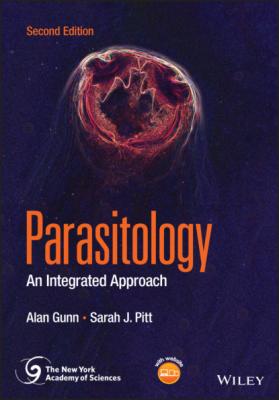Parasitology. Alan Gunn
Чтение книги онлайн.
Читать онлайн книгу Parasitology - Alan Gunn страница 26
 There are currently no records of them being parasitic or acting as hosts for parasites. However, they harbour rickettsia and bacteria endosymbionts, and it would be surprising if other microbes and viruses did not parasitize them. Interestingly, T. adhaerens is currently the only metazoan animal known to express the protein ‘apicortin’ (Orosz 2018). Apicortins probably help stabilize microtubules and are characteristic of apicomplexan parasites such as malaria and certain free‐living algae to which they are distantly related. It is uncertain whether the placozoans acquired the apicortin genes from consuming algae or sharing genes through long distant evolutionary events.
There are currently no records of them being parasitic or acting as hosts for parasites. However, they harbour rickettsia and bacteria endosymbionts, and it would be surprising if other microbes and viruses did not parasitize them. Interestingly, T. adhaerens is currently the only metazoan animal known to express the protein ‘apicortin’ (Orosz 2018). Apicortins probably help stabilize microtubules and are characteristic of apicomplexan parasites such as malaria and certain free‐living algae to which they are distantly related. It is uncertain whether the placozoans acquired the apicortin genes from consuming algae or sharing genes through long distant evolutionary events.
2.5.1 Parazoa
The Parazoa are organisms that lack true tissues. This group contains either only the phylum Porifera, better known as the sponges, or two phyla, the Porifera and the Placazoa depending upon one’s taxonomic preferences. All sponges are aquatic and gain their nutrition through filter feeding and, in some cases, in a symbiosis with algae or bacteria. Sponges belonging to the family Clionaida bore into the shells of molluscs and penetrate the calcareous skeleton of corals (Mote et al. 2019). Other sponges will, in their turn, exploit the burrows and also grow over them. Some workers refer to this as parasitism, although this is debatable.
2.5.2 Eumetazoa
The Eumetazoa comprise those animals containing recognisable muscles, nerves, and other tissues. This group contains the vast majority of animal phyla (i.e., all vertebrates and most invertebrates). One can identify two sub‐group of eumetazoans on the basis of their embryonic development. These are the diploblasts and the triploblasts. Diploblastic animals are those that form only two germ layers during embryonic development. These layers are the outer ectoderm and the inner endoderm. Only two phyla exhibit this form of development: the Cnidaria (e.g., jellyfish, sea anemones, and hydra) and the Ctenophora (sea gooseberries). Virtually all members of these two phyla are free‐living and most are predatory, although there are a small number of exceptions. For example, among the Ctenophora, juveniles belonging to the genus Lampea begin life as external parasites of salps. However, as they mature and become larger, the relationship changes to one of predation in which they engulf and consume the salp to which they initially attached. Intriguingly, some ctenophores are hosts to the parasitic planula (larval stage) of the sea anemone Edwardsiella carnea. Among the Cnidaria, the best‐known parasitic species Polypodium hydriforme infests the eggs of freshwater fish (e.g., sturgeons). Polypodium hydriforme spends most of its life cycle within the eggs in the ovaries of its fish host. When the fish spawns, it leaves and forms a free‐living medusiform‐like stage (i.e., resembling a small jellyfish) before subsequently infecting another female fish. The genus Polypodium is currently considered a sister group to the Myxozoa within the Cnidaria (Okamura and Gruhl 2016). The myxozoans are a highly unusual group of parasitic cnidarians with complex life histories. Most species utilise a fish intermediate host and an annelid or bryozoan definitive host. However, there are few species, such as Soricimyxum minuti, that utilise shrews and other mammals as intermediate hosts (Székely et al. 2015). The most economically important species is Myxobolus cerebralis that causes ‘whirling disease’ in wild and farmed salmonid fish, such as trout and salmon. The parasites develop into myxospores within the cartilage of the vertebrae and skull (as well as other organ systems) of infected fish. This results in deformity and a characteristic ‘whirling’ motion in which the fish appears to chase its tail. The mortality rate can exceed 90%, and after death, the spores enter the surrounding water. The next stage of the life cycle requires ingestion of the myxospores by Tubifex spp. worms. Within the worms, the parasite undergoes sporogony to form sporocysts that contain triactinomyxon spores. Completion of the life cycle then occurs through either of two events. It might be through a fish consuming an infected Tubifex worm or through the worm releasing the triactinomyxon spores with its faeces into the surrounding water. In the latter circumstance, the spores rapidly penetrate the skin of a suitable fish host upon contact.
Triploblastic animals are those in which a third germ layer, the mesoderm, develops during embryogenesis: the mesoderm forms between the outer ectoderm and the inner endoderm layers. Most invertebrate species and all vertebrate species are triploblastic organisms. One can divide triploblastic animals into three broad categories based on their internal morphology: acoelomates, pseudocoelomates, and coelomates. The acoelomates are those that lack a body space (coelom) other than the gut (e.g., phylum Platyhelminthes: tapeworms, flukes). The pseudocoelomates, also known as the blastocoelomates, have a characteristic pseudocoelom (blastocoelom) between the gut and the body wall (e.g., phylum Nematoda: nematodes). A pseudocoelom is a body cavity that develops temporarily in most metazoan animals during embryonation, but in the pseudocoelomates it persists into adulthood. Coelomate animals (also known as eucoelomates) are those in which a true coelom (body space surrounded by mesoderm) develops between the gut and the body wall (e.g., phylum Annelida [earthworms], phylum Arthropoda [scorpions, crabs, insects], phylum Vertebrata [fish, amphibians, reptiles, birds, mammals]). There are numerous examples of triploblastic invertebrate species that are parasites of other organisms as well many that act as the intermediate hosts or vectors of parasites.
3 Parasitic Protozoa Part A: Phyla Rhizopoda, Metamonada, Apicomplexa
CONTENTS